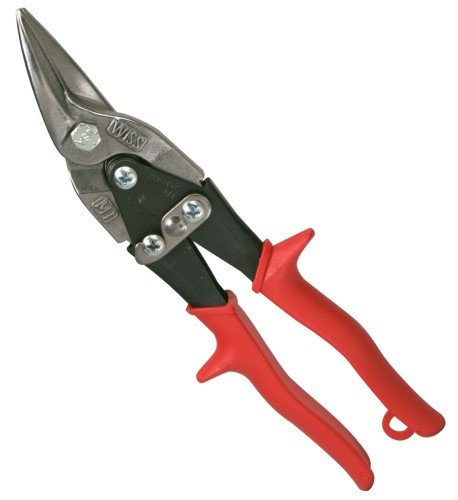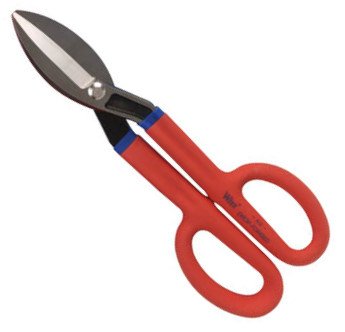If you're looking for roofing tools, you've come to the right place. It's been said: "If your only tool is a hammer, every problem looks like a nail". So it's always best to have the right tool for the job. It will help you do quality work and do it fast. Many projects require special roofing tools, but these are the ones that go with me to every job.
#10 -- Pry Bar
The pry bar, or "flat bar" as it is sometimes called is the "Swiss Army Knife" of roofing tools. I've used mine for everything from pulling nails to pounding them in, to cutting wood, cutting metal and popping shingles loose for repairs. Be sure to get a second one for back-up... and for two-handed staple pulling. A good choice is the Stanley Wonder Bar.
#9 -- Utility Knife
A sharp knife is handy for both removing the old material and installing the new stuff. Go with a model that allows you to change blades fast -- without tools. I've found that knives with retractable blades tend to get gummed up with roofing tar. As such, I prefer a knife with a fixed blade. My preference is a Stanley Model 10-399.
And you really should have two knives in your tool belt. Keep each knife filled with half straight blades and half hook blades. The straight blades cut well on the back of the shingles. The hook blades cut well on the front. This saves a lot of time switching back and forth between blades. The second knife also gives you a backup with both types of blades in it should you misplace one of them.
#8 -- Hand Broom
You might not think a hand broom belongs on a top ten list of roofing tools, but a good clean up is an important part of every job. While scoop shovels and push brooms are fine for the big stuff, I've found that a hand broom is just right for the little stuff. And a Marshalltown #6519 is a good heavy-duty model to get.
#7 -- Hand Saw
Fixing rotted wood is a pretty common task for us roofers. I USUALLY have a circular saw and a reciprocating saw on site for the task, but a hand saw is one of the roofing tools that I ALWAYS have with me. Small cutting jobs can be handled in less time than it takes to run an extension chord. And it has saved the day many times over the years, when electrical power should have been available, but wasn't. I like the Stanley 20-045 Model which has a tough, long-lasting blade and is small enough to fit in my tool bucket.
#6 -- Measuring Tape
You'll also need a measuring tape to help with those wood repairs and to layout the new roof. I like a 25-footer with a stiff 1" blade. Almost any brand will do, but the Craftsman brand has a lifetime warranty.
#5 -- Metal Snips
Most "tinners" use dedicated snips for right and left cuts. But I've found that Wiss M3R Straight Cut Tin Snips (Yellow Handle) works fine for most all of my metal work.
When they eventually lose their edge, I replace them and use the old ones to cut shingles around pipes and vents. That's often quicker and easier than using a knife.
#4 -- Hand Seamer
This is one of those roofing tools that you don't use every day, but it sure comes in handy when doing flashing work. It's just the right size for making tight drip edge laps. It's also handy for making inside and outside corners as well as other miscellaneous bends. The one to get is a 3" Malco Model S-2
#3 -- Chalk Box
Of all the roofing tools I've had over the years, chalk boxes have caused me the most grief. They never seemed to hold enough chalk or chalk a consistent line. And the string always seemed to break just when I was in a big rush. The plastic reduction drives broke and the strings tangled within the box. It drove me nuts. That kept me constantly on the search for a better chalk box.
I found the "Mother of all Chalk Boxes" a few years ago with the purchase of a "Little Giant" by Keson. It uses a heavy line which I have yet to break. The line sucks up a lot of chalk, so you get a good solid mark. And you can fill the chalk box in seconds with a whole bottle of chalk at a time. You can retrieve the line fast and mine hasn't tangled yet. Be sure to get two. One for permanent red dye you can use on the underlayment and one for temporary blue chalk you can use on the shingles.
#2 -- Trowel
Just about any small trowel will do for spreading flashing cement, but the flat nose type, like a Marshalltown #11202 Margin Trowel, is good for cleaning out the bottom of buckets. If you're doing a lot of mud work, you will want to get a big brick trowel like a Marshalltown #10109. It can lay down a 10" mortar pad for tile in one swoop. It's helpful to grind the point down to make it easier working out of a five gallon pail.
#1 -- Hammer
No list of roofing tools would be complete without a hammer. In fact, some say: If it can't be fixed with a hammer, it can't be fixed! I wouldn't go quite that far, but it is essential for nearly every roofing job. My favorite is an Estwing Model E3-20 S. That's their 20 oz. Rip Hammer. It has enough weight to seat nails with one smack and it has a straight claw for digging out nails. It's virtually indestructible and carries a lifetime guarantee.
Canon S70 Coupon Save Jessner Peel Bicycle Trainer Fluid Purchase












